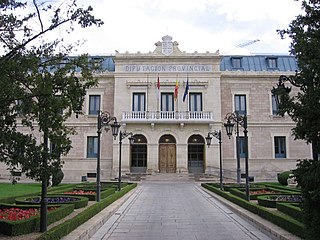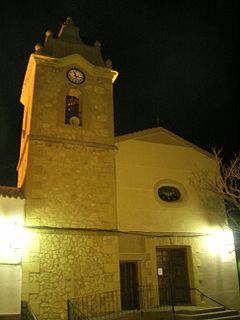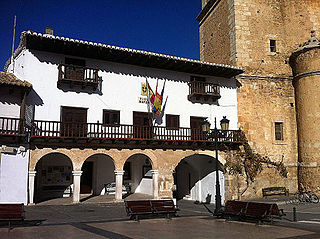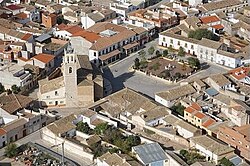
Castilla–La Mancha, or Castile La Mancha, is an autonomous community of Spain. Comprising the provinces of Albacete, Ciudad Real, Cuenca, Guadalajara and Toledo, it was created in 1982. It is bordered by Castile and León, Madrid, Aragon, Valencia, Murcia, Andalusia, and Extremadura. It is one of the most sparsely populated of Spain's regions. Albacete is the largest and most populous city. The government headquarters are in Toledo and the High Court headquarters are in Albacete.

Cuenca is one of the five provinces of the autonomous community of Castilla-La Mancha. It is located in the eastern part of this autonomous community and cover over 17,141 square km. It has a population of 203,841 inhabitants- the least populated of its autonomous community. Its capital city is Cuenca and the province is compounded of 238 municipalities.

La Mancha is a natural and historical region located in the Spanish provinces of Albacete, Cuenca, Ciudad Real and Toledo. La Mancha is an arid but fertile plateau that stretches from the mountains of Toledo to the western spurs of the hills of Cuenca, and bordered to the south by the Sierra Morena and to the north by the Alcarria region. La Mancha includes portions of the modern provinces of Cuenca, Toledo, and Albacete, and most of the Ciudad Real province. La Mancha historical comarca constitutes the southern portion of Castilla-La Mancha autonomous community and makes up most of the present-day administrative region.

Cuenca is a city in the autonomous community of Castile–La Mancha in central Spain. It is the capital of the province of Cuenca.

Albacete is a city and municipality in the Spanish autonomous community of Castilla–La Mancha, and capital of the province of Albacete.

Tobarra is a municipality in the province of Albacete in Spain, with a population of c. 8,000 as of 2009.

San Roque is a small town and municipality in the south of Spain. It is part of the province of Cádiz, which in turn is part of the autonomous community of Andalusia. San Roque is situated a short way inland of the north side of the Bay of Gibraltar, just to the north of the Gibraltar peninsula. The municipality has a total surface of 145 km² with a population of approximately 25,500 people, as of 2005. Its name is Spanish for Saint Roch, a Christian saint who was revered in a shrine dating back to 1508 that predates the foundation of the town.

Villarrobledo is a Spanish city and municipality in the province of Albacete, part of the autonomous community of Castile-La Mancha. It's better known for having the world's largest area covered by vineyards as well as the world's greatest production of La Mancha wine, called in Spanish Denominación de Origen. Also, it is an important center of Manchego cheese production and export and has other important industries like metallurgy and transportation.

Higueruela is a municipality located at 43 km east of Albacete, Castile-La Mancha, Spain. It has a population of 1,350. The land surface is around 205.4 km² and its population density is calculated at 6.5/km².

San Pedro, Albacete is a municipality in Albacete, Castile-La Mancha, Spain. It has a population of 1,319. It is located 36 kilometers from Albacete. Nearby towns: Pozuelo, Balazote or Casas de Lázaro.

Tarazona de la Mancha is a municipality in the province of Albacete in the Autonomous community of Castile-La Mancha, Spain. It had a population of 6,647 at the 2011 census.

Campillo de Altobuey is a municipality in Cuenca, Castile-La Mancha, Spain. It has a population of 1,691.

Aras de los Olmos is a municipality of Valencia, Spain. Belonging to the province of Valencia, in the region of Los Serranos.
Villanueva de la Jara, popularly called La Jara, is a town and municipality in the Manchuela Conquense cormarca, this in turn is part of the La Manchuela comarca, province of Cuenca, in Castile-La Mancha, Spain. It is known for the cultivation of portobellos which is the main economic activity of the locality and other edible fungis.
Baños de Valdearados is a municipality and town located in the province of Burgos, Castile and León, Spain. According to the 2004 census (INE), the municipality has a population of 424 inhabitants.

Tosantos is a municipality and town located in the province of Burgos, Castile and León, Spain. According to the 2004 census (INE), the municipality has a population of 60 inhabitants. Tosantos is located on the Camino de Santiago de Compostela, a 1200-year-old pilgrimage route that runs through France and Northern Spain to the Spanish city of Santiago. The hamlet has a pilgrim hostel which is open from April through October and hosts up to 50 pilgrims a night.

Salinas del Manzano is a city of Spain in the province of Cuenca in the autonomous community of Castile-La Mancha. It has an area of 33.65 km2 with population of 105 inhabitants and a population density of 3.21 inhabitants / km2.

The University of Castilla–La Mancha (UCLM) is a Spanish university. It offers courses in the cities of Albacete, Ciudad Real, Cuenca, Toledo, Almadén and Talavera de la Reina. This university was recognised by law on 30 June 1982, and began to operate three years later.

The Church of Nuestra Señora de la Esperanza is an 18th-century, Roman Catholic parish church located in Peñas de San Pedro, province of Albacete, autonomous community of Castile-La Mancha, Spain.
Santa Quiteria is a Neoclassic, Roman Catholic parish church in Higueruela, province of Albacete, Community of Castile-La Mancha, Spain.




















